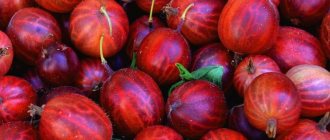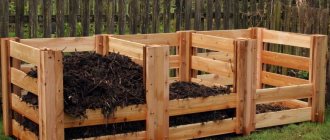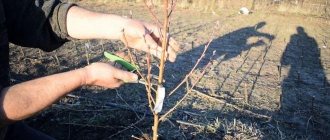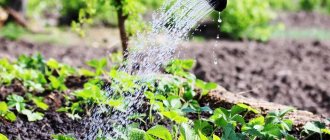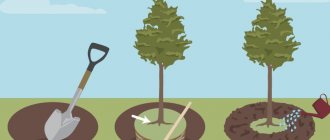Why trim?
Pruning must be done to achieve the following goals:
- regulation of the plant life cycle;
- increased growth of new shoots;
- acceleration and improvement of fruiting;
- control over the amount of harvest so that the branches do not break under the weight of the fruit;
- reduction of crown volumes for improved lighting and air exchange;
- prevention, creating unfavorable forces for diseases and pests, strengthening the immune system;
- giving additional resistance to wind so that it does not break branches;
- correct formation of a strong and beautiful crown, giving it decorative properties;
- preparation for wintering, increasing cold resistance;
- maintaining optimal conditions for growth and development, eliminating depletion and activating the formation of ovaries.
A properly carried out procedure involves removing part of the crown. At the same time, the plant experiences stress and turns on protective mechanisms of enhanced regeneration - the formation of new, stronger shoots. For the same reason, fruiting improves. If pruning is not carried out, the consequences will not please the garden owner:
- the fruits are born small, dry and tasteless;
- over time, fruiting decreases and becomes irregular;
- due to excessive crown density and lack of light, fruiting branches die off;
- the tree becomes vulnerable to diseases and pests;
- frost resistance decreases.
How to do everything right?
There are certain rules and regulations that will allow you to prune correctly:
- Deep pruning is done no more than twice a year, since this is too stressful a procedure that can lead to the death of plants.
- If rapid growth is needed, as many fruiting buds as possible are removed.
- It is imperative to observe the subordination (uniform number) of main and secondary branches, so as not to get a crown that is too thick or too thin.
- Branches should not be left growing at an acute angle to the trunk.
- The best in terms of fruiting are horizontally growing branches - to increase productivity, these should be left.
- In the first year of life, pruning seedlings has only one goal - crown formation. It’s too early to think about productivity.
- What crown shape was chosen for the fruit tree or shrub initially - this scheme must be followed in the future. Changing it will be extremely difficult and traumatic for the plant.
- You cannot approach pruning all fruit trees the same way. The features of the procedure will depend on the type (apple tree, walnut, pear, peach, apricot, for example), on the variety, on individual properties (age, previous diseases, etc.).
- You should always start with sanitary pruning. She is more important than others. Perhaps she will remove everything unnecessary, so that other types of haircuts will not be needed.
- The cut material is burned outside the site so that the remaining plants do not become infected with fungus or become a new haven for pests.
And finally, one of the most important rules: “Measure twice, cut once.” Think carefully before removing this or that branch. If you're not sure, don't cut it.
Necessary equipment
Tools for pruning fruit trees must be well sharpened. Otherwise you won't be able to make a clean cut. The uneven edges of the wound can become inflamed or become a gateway for infection to enter the trunk. This will cause the plant to dry out.
What tools might be useful:
- pruning shears - for removing branches of small diameter;
- lopper - for those at heights;
- brush cutter - for removing branches on bushes with a dense crown;
- garden hacksaw and bow saw - for thick branches;
- garden knife - to remove young, thin shoots, to clean up uneven cuts.
All tools must be disinfected to avoid introducing fungus or pest eggs left on the blades after previous pruning into the wound.
Preparing tools for work
How to trim trees and shrubs? First you need to prepare your tools . You will need a sharp garden knife (for cutting thin and small tree branches) and pruning shears (for thicker shoots). You may also need a hand saw to remove thin trunks and a saw for large ones.
If you plan to trim thorny branches of bushes , you need to prepare a lopper with long handles. All prepared tools must be put in order - blades must be cleaned, sharpened and disinfected.
In addition, you will need a chisel, stepladder and metal brush to clean the cuts.
MOST READ FROM PARTNERS
And, of course, don’t forget about products for covering fresh wounds. We advise you to use garden pitch, natural drying oil or oil paint.
Types of pruning
The choice of type of pruning of a fruit tree depends on the goals:
Forming / forming
The goal is to form a correct, strong, beautiful crown according to a certain, pre-selected pattern. The strongest shoots are left, located in the right place and at an acceptable angle. This creates a strong skeleton of the fruit tree. It is carried out starting from the first year of life and ending with the 5th-6th. It is used throughout the season - from spring to autumn.
Regulatory
The goal is to maintain the result of shaping. Allows you to preserve the decorative properties of fruit trees and increase their productivity. Produced regularly.
Rejuvenating / renewing / deep
The goal is to extend the life of the plant and improve productivity. Deep pruning aimed at rejuvenation is carried out at 7-8 years, when old branches need to be replaced with new ones. It is the largest, as it is often necessary to remove almost half the crown at a time.
Restorative/sanitary
The goals are to restore the fruit tree after winter, treat and prevent various diseases, strengthen the immune system, and maintain health. Such “first aid” can be provided at any time, if necessary.
Which branches are removed during sanitary pruning of fruit trees:
- dried out;
- broken, broken;
- patients affected by fungus or pests;
- split;
- stumps remaining from previous pruning if it was done incorrectly.
Which branches are removed during formative and regulating pruning:
- intersecting, intersecting with each other and with the trunk;
- lapping the barrel;
- launched into the crown of neighboring trees;
- growing inside the crown;
- preventing the normal growth of neighboring plants;
- parallel duplicating;
- split off codominant trunks and stepsons;
- top;
- water shoots, root and stump shoots;
- oppressed stepchildren.
Sanitary pruning involves removing mostly dead branches, while shaping and regulating pruning involves removing living ones. In the professional sphere, there are many more types.
Pruning orchard trees - tips for beginning gardeners
Pruning fruit trees is a responsible matter; it has its own nuances and rules. Beginner gardeners should familiarize themselves with these rules before starting the procedure of pruning excess and diseased branches.
Crown formation
Types of pruning fruit trees
Removing unnecessary and weak branches has several objectives, depending on which pruning is divided into several types. Each of them has its own characteristics and consequences. There are formative, sanitary and rejuvenating pruning.
Crown formation
First of all, tree pruning is needed to properly form the crown and prevent its excessive growth. As a result of the procedure, a strong skeleton is created, side branches begin to grow actively and the gardener receives more fruits.
If pruning is done rarely or is ignored altogether, the crown reaches enormous dimensions, and the fruits are located in hard-to-reach places. It is recommended to start thinning the crown next year after planting. Most often, gardeners choose two schemes: tiered and sparsely tiered.
Important! The best time for booking is the end of February - beginning of March. It is important not to be late, otherwise the trees will lag behind in development and will not bear fruit.
Sanitary pruning of fruit trees - what you need to know
Annual autumn pruning of diseased or dry branches is called sanitary pruning. It is carried out as follows:
- The shoots are removed above the outer bud, the skeletal branch is cut into a ring.
- The diseased and withered branch is cut off, including the healthy part.
- A vertically located branch is cut with an oblique cut.
- After completing the procedure, the wounds must be lubricated with garden varnish or other means.
Regular sanitization heals the plant and increases its fruitfulness. The tree lives for a long time, and the risk of various diseases of fruit crops is significantly reduced.
Purpose of anti-aging pruning
Rejuvenating pruning is performed when there are too many old trees in the garden, whose yield has noticeably decreased. The following procedure is recommended:
- Inspect the crown, identify any dying, crossing, rubbing or growing branches in the center.
- At the base of these branches, find a strong fatty shoot.
- Step back 2 cm from the base of the shoot and cut down the branch.
- Treat the cut area with garden varnish.
If there are not one, but several young shoots next to the cut, the wound will heal faster.
Important! Rejuvenating tree pruning must be spread out over several years, removing old branches gradually. If you get rid of them right away, the plant will weaken and die.
Types of trimmings
Safety precautions for pruning fruit trees
Pruning trees in the garden requires compliance with safety rules:
- Do not allow children under 18 years of age to perform pruning or allow children under 18 years of age to approach the site of the procedure.
- Use protective gloves to prevent cuts or splinters, as well as helmets and goggles.
- Use a stepladder (not a ladder!) with sufficiently wide steps. To avoid slipping on the stairs, wear shoes with grooved soles. Do not climb the stairs together.
- Do not use electrical appliances with damaged cables or wires.
- Do not perform crowning near electrical wires.
- Do not walk from a ladder onto a tree, or work during or immediately after rain. Do not stand with one foot on a ladder and the other on a tree.
- Do not stand under the tree while it is being thinned.
- Make sure that your working tools are in good condition, do not throw them around, and store them in special bags or cases.
- Use special hooks to remove cut branches.
Important! Pruning trees 3 m or more in height should be carried out together with a partner for insurance.
Selection of tools and equipment
When choosing pruning tools, you should follow the advice of experienced professional gardeners:
- The tool should fit comfortably in your hands.
- A hacksaw, pruner or grafting knife should have brightly colored parts so that they can be easily found in the grass.
- It is advisable that the equipment be equipped with special loops, so that it can be hung on the wrist and not dropped while working.
- Under no circumstances should you cut branches with a rusty tool, otherwise the tree may die.
Secateurs
For proper and high-quality pruning of garden trees, you will need the following tools:
- A lopper on a rod - useful if you can’t climb a ladder.
- Hacksaw - used to cut down branches with a large diameter. You cannot use a chainsaw; the wounds it makes on wood practically do not heal.
- A garden knife is convenient for cleaning finished cuts; it must be perfectly sharp.
- Secateurs are a convenient and safe tool for pruning small branches.
Fresh cuts need to be processed. To do this you will need garden pitch, drying oil paint, Rannet paste or other similar products.
Cutting technique that allows you not to injure the tree
When cutting down large branches, the tree can be injured. To prevent this from happening, cutting is done as follows:
- Make an initial undercut from below so that the branch does not break and tear off the bark from the tree.
- Next, you need to cut down the branch above the cut you made.
- After removing the branch, the cut is leveled into a ring, the irregularities are cleaned out with a knife and the wound is lubricated with paint or varnish.
Types of fruit trees and their features
There are different types of fruit trees, and each of them has its own characteristics, which must be taken into account when pruning.
- Pomaceae
During fruiting, weakly growing rootstocks are pruned more heavily, as they are more overloaded with the harvest, which leads to a decrease in the quality of the fruit.
- Stone fruits
Early fruiting, which is why the process of crown formation lasts 5-6 years. Pruning stone fruit trees speeds it up, but requires a good agricultural background, otherwise weakened plants begin to develop severe gum production.
- Nut-bearing
It is believed that they do not need to be pruned, since nut-bearing plants are originally wild-growing plants and in nature do without this procedure. However, there is then a risk of crushing the crop. In this case, you should prepare for profuse lacrimation.
- Oilseeds
The most convenient crops for pruning. Firstly, it is well tolerated. Secondly, they quickly adapt to the new crown shape. Thirdly, haircuts are carried out only once a year - in the spring.
- Tonic
With the help of pruning, these plants can be formed as a small standard tree (if only one strong shoot is left) or a decorative spherical bush. Both types of crowns will bear fruit well.
- Spicy
There are no special secrets. Submit to general rules.
- Citrus
It is recommended to prune only after the branch stops growing. You can recognize this by its characteristic feature: its leaves, which were previously light green and tender, become darker and harden.
- Variegated subtropical
Without pruning, the fruits are concentrated on the peripheral shoots, which leads to branches breaking off. Therefore, you need to regularly trim the young growth to 2 lateral buds.
- Variegated tropical
When growing tropical fruits in a garden, you must constantly monitor their height so that they do not fall into the arrow. Therefore, twice a year you need to trim the top and form a thick crown.
We'll tell you how to care for the crown of actively fruiting trees.
As a rule, caring for them, in addition to watering and fertilizing, comes down to thinning the crown in places where the branches are intertwined or heavily thickened.
How to prune trees in spring?
- An overgrown crown should be thinned out gradually over two to three years. This way the tree is less damaged and suffers. In this case, it is necessary to remove those shoots that intertwine and grow inside the crown.
- Small branches are removed with a knife or pruning shears, thick ones with a saw.
- The basic rule for pruning a large branch is this: it must be removed in three approaches, without leaving a stump, that is, “on the ring.” A ring is the boundary between a branch and a trunk or between a large and small branch.
The following picture shows how to do this correctly.
Actively fruiting trees also need to shorten their branches to resume their growth processes.
Types of crowns
To form the crown, young trees are pruned according to a certain pattern.
Sparsely tiered crown
A loose hemispherical crown with pronounced tiers. Recommended for pears, apples, cherries, plums and cherries. How is it formed in the first year of life:
- For the lower tier, 2-3 strong branches are left, evenly spaced around the trunk at a distance of 50 cm from the soil.
- Next, 60 cm is measured upward from it and a second tier is formed from another 2-3 branches, but they should be more sparse.
- All excess shoots are removed.
- The top is cut off at a distance of approximately 50 cm from the second tier.
The third tier is formed in the second year of life. But there are exceptions. It is allowed to create it on very young seedlings in the southern regions or on weakly branching trees.
Advantages: universal, simple, controls the height of the fruit, suitable for strong and weak growing rootstocks. Disadvantages: the order of placement of branches in tiers must not be disturbed; the intervals between them must be strictly observed; not recommended for varieties that need a lot of sun.
Whorled-tiered (five-parted)
A free hemispherical crown with tiers in which the branches are arranged in close whorls of several pieces. Recommended for any fruit trees. How to form the lower tier in the first year of life:
- At a distance of 50 cm from the soil, find the bud of the first skeletal branch.
- Measure 30 cm up from it, leave 2 more buds in different directions.
- Above the 4th bud, cut the stem without the stump. A continuation shoot will rise from it.
In the second year, the following tier is formed:
- On the continuation shoot, measure 50 cm up.
- Leave 3 buds with an interval between them of no more than 30 cm.
- Measure up another 40 cm.
- Leave 2 buds, cut off the rest.
To maintain the shape of the crown, in the future it is necessary to regularly remove new branches from the trunk.
Advantages: simplicity, short crown formation time. Disadvantages: the trunk may lack nutrients due to the large number of skeletal branches, decreased frost resistance, difficulties with harvesting, since the fruit tree grows quite tall.
Tierless
A free hemispherical crown with skeletal branches evenly sparse along the trunk. Recommended for highly branched fruit trees, as it turns them into small ones. With its help you can save space in the garden. Forming rules:
- 5-8 skeletal branches are left, sparse along the trunk at a distance of 40 cm from each other.
- The growth angle is at least 45°.
- The trunk is pruned at a distance of 20-30 cm from the last branch.
- Pyramidal fruit trees are pruned to the outer bud to form the widest possible crown.
- Pruning to the internal bud is used for fruit trees with a spreading crown and hanging branches.
Advantages: strong skeleton, lots of sunlight. Disadvantages: long period of crown formation.
Combined
A loose hemispherical crown with poorly formed tiers and spare shoots left behind. Combines various features of the above-described schemes. Recommended for all varieties. How it is produced:
- On the lower tier, 3-5 branches are left through 2-3 buds. They must look in different directions.
- One spare escape is left.
- Next, the skeletal branches are left so that a distance of 40 cm is maintained between them.
- The lower branches are raised (tied up if necessary).
- The upper ones are leveled with clothespins and spacers to a horizontal state.
Advantages: combines all the advantages of the crown forms already described. There are no disadvantages.
Fusiform (spindlebush)
Hemispherical crown with a large number of semi-skeletal horizontal branches. Recommended for low-growing, early-fruiting trees. How it is formed:
- Skeletal branches are left in a spiral (every 4 buds from each other).
- At the end of summer, already in the first year of life, the branches are forcibly given a horizontal state.
- In the spring of next year, the continuation shoots are cut at a distance of 40 cm from the uppermost horizontal branch.
- This algorithm must be repeated for 7 years.
For fruit trees on dwarf rootstocks, there are different options for forming such a crown:
- flat spindle bush;
- free-growing spindle-shaped bush;
- Groesbeck;
- spindle.
Advantages: increase and acceleration of fruiting, presence of variations. Disadvantage: this crown formation scheme is one of the most painstaking, complex, troublesome and labor-intensive.
Bush-like (bush-like)
Several main trunks with a wide angle of departure. Recommended for vigorous, abundantly branching fruit trees and northern latitudes. How to form:
- Leave 3 symmetrically located branches, each of which will become a full-fledged trunk.
- Trim them to 4 buds.
- Cut the branches below to 20 cm.
- Next year, remove another 15 cm from them. Leave the skeletal ones in the same form.
- After a year, select 10 two-year-old branches and cut to 70 cm.
- Remove side shoots up to 3 buds.
There are several options for schemes: slate-bush and low-standard. Advantages: low growth and frost resistance. Disadvantage: not recommended for weakly branching and low-growing plants.
Semi-flat
Semi-flat compacted crown with a well-developed trunk and several skeletal branches of the 1st order. They should be located in the plane of a row of 2 in each tier (at a distance of 1 m from each other). The minimum angle formed with the barrel is 45°. The center conductor is trimmed regularly to control the height of the fruit.
The form is recommended for pears, apples, apricots and plums. Advantages: simplicity and early pregnancy. There are no cons.
Flat
Types of flat crown:
- palmette - skeletal branches of the 1st order are in the same vertical;
- cordon is an upwardly extended trunk on which short fruit-bearing branches are evenly spaced.
Recommended for those gardeners who have to plant fruit trees close to each other. The main advantage is early pregnancy. Disadvantages: long development time, availability of certain skills, complexity.
How to prune young trees correctly?
So, having chosen the right time and armed with the necessary gardening tools, get to work. First, remove dead, broken, diseased, pest-damaged, and weak branches. Then remove any root growth that is interfering with the maintenance of the soil under the tree.
Having carried out a standard procedure suitable for all trees without exception, you can proceed to direct pruning, which has its own specific characteristics for trees of different ages.
Young samples mainly require shoots to be shortened . During the period of active fruiting, thinning will be required, and during the aging period, removal of a significant number of branches and shortening of shoots.
How to prune young trees?
- First, several powerful skeletal branches (3–5 pieces) are selected. It is desirable that they extend from the trunk at an obtuse angle and are at a sufficiently distant distance from each other.
- The selected branches are shortened slightly to allow lateral branches to form. In this case, they are guided by the rule: the lower shoots are cut to a shorter length, the upper shoots to a longer length.
- The remaining branches are shortened by 10-15 cm. The main vertical shoot is cut 35–40 cm above the uppermost shortened skeletal branch.
Deadlines
One of the most controversial and pressing issues is the timing of pruning fruit trees and in which month which pruning is recommended.
- Spring
In the southern regions, spring pruning can begin in March. In the rest - when the air temperature constantly remains at 5°C. First of all, sanitary work is carried out to remove branches damaged during the winter. And only then - to form the crown. The main thing is to catch the active sap flow before the buds bloom.
- Summer
In summer, fruit trees are allowed to be pruned only when necessary. In the event of a pest attack or fungal infection, damaged, diseased branches are urgently removed
- Autumn
This is the best time for this procedure. Autumn pruning of fruit trees prepares them for the winter, increases frost resistance and immunity, and allows for proper distribution of nutrients between the branches. It is best to do this in October, when the sap flow slows down. In southern latitudes it is possible in November. The main thing is that the temperature does not drop below 0°C.
Is it possible to prune trees with foliage? Definitely not, because this is a sure sign that the sap is still active and can cause serious injury to the plant.
- Winter
Winter pruning can be carried out without any problems in the southern regions. February is suitable for central Russia, unless the air temperature drops below -5°C.
The table below clearly shows in which regions which trees are pruned in the fall, and which in the spring and summer, when to start the procedure and what exactly to do.
Processing after
It is important to treat the cut after trimming. If it turns out to be large in diameter (more than 1 cm), it is lubricated with disinfectant and wound-healing compounds. For this, iron or copper sulfate, a weak manganese solution, 3% Bordeaux mixture, fungicides or store-bought balms are used. After this (the next day or a few hours later), agents are applied to the wound that accelerate regeneration:
- garden var;
- heteroauxin;
- manure-clay mixture;
- cement mortar;
- artificial bark.
Experienced gardeners do not recommend treating the cut with oil paint, as it can be toxic.
How to use the garden varnish:
- Carry out processing in warm, dry weather.
- Warm the ointment in your hands or in the sun.
- Apply with a brush to the cut - evenly and in a thin layer.
- If the cut diameter exceeds 15 cm, cover it with a rag.


